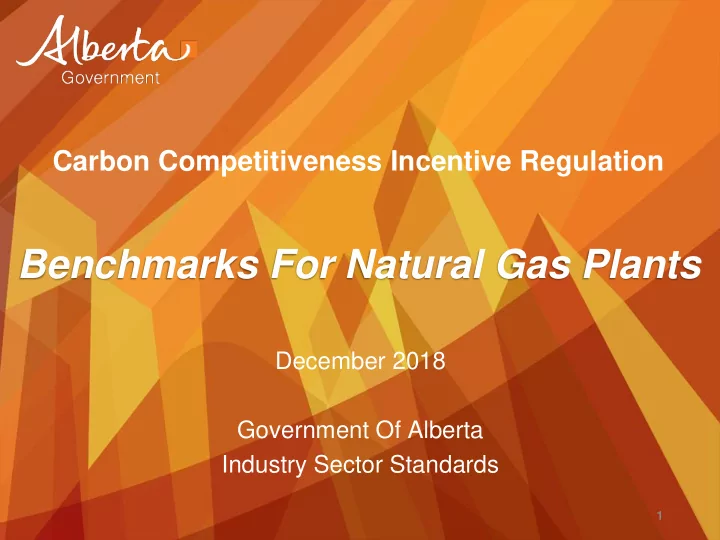

Carbon Competitiveness Incentive Regulation Benchmarks For Natural Gas Plants December 2018 Government Of Alberta Industry Sector Standards 1
Overview • Background and Sector overview • Benchmarking Data Collection • Benchmarking Results • Economic Analysis • Final Gas Plants Benchmarks 2
Sector Overview • Majority of facilities are not large final emitters (LFEs). • 33 out of about 500 natural gas processors are LFEs and subject to carbon pricing (~25% of production). • LFE facilities employ about 1400 people. • Natural Gas Processing sub-sector emitted 14.7 MT CO2e in 2015 • Natural Gas LFE’s emits approx. 6 MT of CO2e per year (4.4 % of LFE emissions ) Natural Gas Processing Sub-Sector Natural Gas Processing Greenhouse Gas Emissions (in Mt CO2e) Emissions - by Gas Type Methane Nitrous oxide 6.8% 0.2% LFE Natural Gas Non LFE - Processing Natural Gas 6 Carbon Dioxide Processing 93% 8.7 3
Background • Up until the end of 2017, facilities were regulated under the Specified Gas Emitters Regulation. – Subject to facility-specific reduction targets. • The CCIR came into effect on January 1, 2018. – Due to data constraints, interim facility-specific benchmarks were assigned until sector-based benchmarks could be developed. • Alberta Climate Change Office (ACCO) collected data from industry throughout 2018, and developed sector-based benchmarks using a modular approach. – The new benchmarks were implemented in November 2018. 4
Background • Natural gas processing facilities not covered under the CCIR are temporarily exempt from the Carbon Levy Regulation. – A significant number of natural gas facilities with emissions below the CCIR threshold of 100,000 tonnes of CO2e are expected to opt in to the CCIR when the carbon levy exemption ceases in 2023. • There are no direct comparisons to a sector-based emissions intensity benchmark for natural gas processing in other Canadian jurisdictions. – In the European Union, facilities receive a fuel/heat facility-specific approach. – California has a single benchmark for conventional oil and gas, and one for natural gas liquids; however, there is no differentiation for complexity, as there is less variance among facilities. 5
Stakeholder Engagement • ACCO regularly consulted with the industry on both the facility level and through the sector’s professional associations including CAPP (Canadian Association of Petroleum Producers) – CCIR engagement process in 2016/17. – December 2017 - webinar introducing the CCIR to the oil and gas sector General – February 2018 - gas plant-specific webinar, discussing interim benchmarks – October 2018 – Meeting with CAPP on new benchmarks for gas plants – Various facility based individual meetings and conference calls throughout 2018 – November 2018 – Sector wide webinar on introduction of new benchmarks for gas plants 6
Benchmarking Data Collection 7
Benchmarking Modules • 29 LFE Gas Processing facilities voluntarily participated in the benchmarking exercise • 15 Different modules were identified within Gas Processing facilities and production/emission data was collected for each. • 13 modules are specific to an individual process • 2 modules ( Formation CO2 and Flaring, Venting, Fugitives, Other ) are general plant wide modules. • Benchmarks have been calculated for 13 modules with the exception of Co/Power Generation (already exists as 0.37 tCO2e/MWh) and Cavern Storage (not enough facilities with this module to establish a benchmark). 8
Distribution of Modules 9
Facilities Production Note: Cubic meter of oil equivalent (m3OE) is a unit of energy based on the approximate energy released by burning one m3 of crude oil. It is used as a way of combining production/throughput into a single measure. 10
Total Emissions per Facility Note: Total emissions above include indirect emissions. 11
Benchmarking Results Sector Single Benchmark 12
Facility Based Emission Intensities 13
Single Benchmark Compliance Overview NOTE: No Transition Allocation was accounted for. 14
Benchmarking Results Modular Benchmarks 15
Modular Benchmarks Compliance Overview NOTE: No Transition Allocation was accounted for. 16
Modular Benchmarks Compliance Overview 17
Modular Benchmarks Compliance Overview 18
Modular Benchmarks Compliance Overview 19
Compliance Cost Overview NOTE: No Transition Allocation was accounted for. 20
Final Gas Plants Benchmarks 21
Natural Gas Processing Benchmarks Benchmarks Type: Modular , 90% PWA, 90% Facility Historic Based formation CO2 22
Alberta Gas Processing Index (ABGPI) • ABGPI is the sum of the products of the individual module weighting factors with the facility’s corresponding throughput or production for each module: ABGPI = Σ (w i *p i ) [ tCO2e ] where w i – weighting factor for module i p i – production/throughput for module i • Natural Gas Processing benchmark is determined as: B = 0.9 tonnes CO2 e ABGPI • Formation CO 2 emissions are allocated on a facility-specific basis separately from the ABGPI. • The methodology for quantification of the ABGPI will be provided in the Quantification Methodologies for the CCIR and the Specified Gas Reporting Program. VP 23
End Of The Presentations 24
Recommend
More recommend